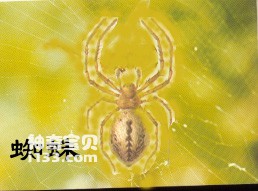Insects belong to Insecta (Hexapoda), a class under the phylum Arthropoda. Therefore, insects have characteristics common to the phylum Arthropods, and at the same time have characteristics that are different from other classes under the phylum Arthropods.
The main characteristics of the Arthropods are:
(1) Body segmentation;
(2) The entire body is covered with Chitinous exoskeleton;
(3) Some body segments have pairs of segmented appendages (such as feet), which is where the name "arthropod" comes from;< br/> (4) The body cavity is the blood cavity.
In the phylum Arthropoda, there are five more important classes, which are briefly introduced to show their similarities and differences with the class Insecta:

Arachnoid(Arachnoidea) The body is divided into two body segments: cephalothorax and abdomen. The head is not obvious and there are no antennae. There are 4 pairs of action legs. They live on land and breathe through the lungs or trachea. Common ones include spiders, scorpions, ticks, mites, etc. Interestingly, ticks and mites are often studied together with Insecta, and there are usually researchers studying ticks and mites in entomological institutes, laboratories or research groups. But it’s important to remember that ticks are not insects.

Crustacea (Crustacea) is aquatic and breathes through gills. The body is divided into two body segments: cephalothorax and abdomen. There are 2 pairs of tentacles. There are at least 5 pairs of walking legs, and most of the appendages are two-branched. Common ones include shrimp, crab, water fleas, etc.
Chilopoda (Chilopoda): terrestrial, breathing through the trachea. The body is divided into two body segments: head and trunk. Has 1 pair of tentacles. Each body segment has a pair of mobile legs, and the first pair of legs is specialized into jaw-shaped poisonous claws. Common ones include centipedes, money strings, etc.

Diplopoda(Diplopoda) is generally the same as the class Chemipoda, so this class and the class Chemipoda are also collectively called Myriapoda. However, except for the 3-4 segments at the front and the 1-2 segments at the end of the abdomen, the body segments of Baryopoda are each composed of 2 segments, so each segment has 2 pairs of mobile legs. The millipede is a common representative of this class.

Symphyla (Symphyla) is very similar to Lamipoda, but the first pair of legs is not specialized into jaw-like poisonous claws. In addition, each body segment usually has a pair of spines and a pair of retractable vesicles. This is very similar to the Dicera of the Insecta class.
animal tags:
We created this article in conjunction with AI technology, then made sure it was fact-checked and edited by a Animals Top editor.